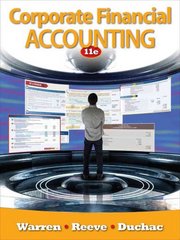Question
1 During its first three years of operations a company reported income before taxes of $1,000,000 in year 1, ($1,800,000) in year 2, and $3,000,000
1 During its first three years of operations a company reported income before taxes of $1,000,000 in year 1, ($1,800,000) in year 2, and $3,000,000 in year 3. The income tax rate applicable to each of the years was 40%. Assume that there weren't any temporary differences and a valuation allowance was not necessary.
How much income tax expense was reported in year 3 if the company elected a loss carryback?
$1,200,000
$ 880,000
$ 480,000
$ 400,000
2 Under IFRS, deferred tax assets:
are not recognized.
require a valuation allowance if it's more likely than not that the deferred tax asset will not be realized.
are recognized only to the extent it is deemed probable that they will be realized.
are reported as current or noncurrent based on the expected date of the reversal of the temporary difference.
3 Which of the following statements does NOT accurately describe the accounting for net operating losses?
A firm must assess future profitability when determining the amount of a deferred income tax asset.
The net operating loss must be carried back two years.
The net operating loss can be both carried forward and backward.
The deferred income tax asset must be allocated between the current and noncurrent balance sheet classifications.
4 During its first three years of operations a company reported income before taxes of $1,000,000 in year 1, ($1,800,000) in year 2, and $3,000,000 in year 3. The income tax rate applicable to each of the years was 40%. Assume that there weren't any temporary differences and a valuation allowance was not necessary.
What is the amount of the deferred income tax asset reported in the year 2 year-end balance sheet if the company elected a loss carryback?
$720,000
$320,000
$400,000
$0
5 A temporary difference created this year causes book income to be greater than taxable income; in future years book income will be less than taxable income. The temporary difference in the future years' incomes is referred to as _____ difference.
reversing temporary
originating temporary
permanent
minor
Step by Step Solution
There are 3 Steps involved in it
Step: 1

Get Instant Access to Expert-Tailored Solutions
See step-by-step solutions with expert insights and AI powered tools for academic success
Step: 2

Step: 3

Ace Your Homework with AI
Get the answers you need in no time with our AI-driven, step-by-step assistance
Get Started


